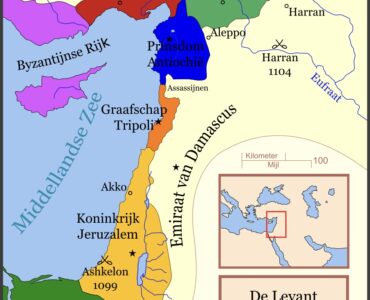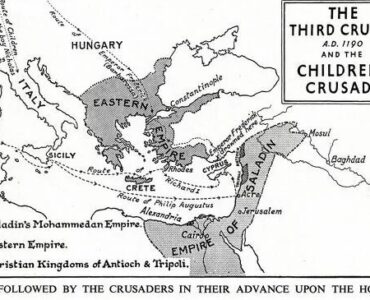
Kanem And Bornu
An early trans-Saharan route connected Tripoli on the Mediterranean with Lake Chad. Kanem (now part of Chad) emerged as one of the earliest African kingdoms on the northeastern corner of Lake Chad.
According to Kitab al-Istibsar, an anonymous work written in 1191, and Ibn Said (1217–86), writing some time after 1269, the people of Kanem converted to Islam at the beginning of the twelfth century. More than in any other early African state in which Islam remained restricted to the court, in Kanem Islam spread throughout the land to the entire population shortly after the king’s conversion. According to the fifteenth-century Egyptian historian al-Maqrizi, the king of Kanem went on a pilgrimage to Mecca and built a madrasa in Cairo for students from Kanem in the first half of the thirteenth century. At the same time a devout Muslim king broke with tradition by opening “a certain thing wrapped up and hidden away, whereon depended their victory in war, called Mune, which no one dared to open.” Traditions suggest that this act brought about the hostilities between the Saifawa ruling dynasty and the rival Bulala clan, of more traditionalist disposition. The Saifawa were forced to abandon Kanem and to resettle in Bornu, on the southwestern corner of Lake Chad. This was in the middle of town l”the fourteenth century, but the Saifawa consolidated their hold over the new country only toward the end of the fifteenth century, with the establishment of the capital at N’Gazargamu.
This took place during the reign of Ali Ghaji ibn Dunama (r. 1476–1503), who is remembered as an exemplary Muslim, always surrounded by ulama, who were his confidants. He was a contemporary of other reformist rulers, such as Rumfa of Kano and Askiya Muhammad of Songhay. He was also the first ruler of Bornu to assume the title of caliph. The claim to the caliphate might have been in response to a similar claim by the Songhay ruler Askiya Muhammad. Ali Ghaji visited Cairo on his way to Mecca in 1484 and met the Egyptian writer and Sufi teacher Jalal al-Din al-Suyuti. It is likely that al-Suyuti obtained the title of caliph from the Abbasid caliph of Cairo for Mai Ali Ghaji, as he had earlier for Askiya Muhammad. The Bornu caliphate reached its peak under Mai Idris Alawma (r. 1570–1603), when all the state dignitaries were Muslim and the capital at N’Gazargamu was an important center for Islamic learning. Qadis, imams, and teachers were granted privileges and were exempted from taxation. The shari’a became the law of the state, which was imposed on the entire population. Mai Idris had diplomatic relations with the Ottomans, who conquered Tripoli in 1551 and annexed Fezzan (in i Libya) in 1577. Fearing the growing power of the Ottomans, in 1582 Mai Idris sent a delegation to the Moroccan sultan al-Mansur (1578–1603) who also had ambitions toward Sudan.
In western Sudan the opening of new sources of gold extended trade routes further south, which encouraged the development of chiefdoms and the spread of Islam. But around Lake Chad the provision of slaves by raids created a hostile boundary. Until the sixteenth century Kanem and Bornu expanded only northward to the Sahara. The countries south of Lake Chad, a hunting ground for slaves, were left outside the boundaries of Bornu. The southward expansion of Bornu was also hindered by natural barriers: the Mandara mountains, the dense vegetation, and marshes created by the seasonal flooding of Lake Chad and the Logon and Shari Rivers. The southern boundaries of Kanem and Bornu were also the southern frontier for the expansion of Islam. After the Ottomans conquered Fezzan, Bornu could not expand to the north and thus turned to the south. Mai Idris occupied the northern parts of the land of the Kotoko as well as Mandara and the region of Lake Fitri. People in the conquered lands became Muslim. About the same time, in the sixteenth century, the state of Bagirmi emerged on the right bank of the Shari River, in a region that had formerly been raided for slaves. Shortly thereafter, the rulers of Bagirmi became Islamized.
The rulers of Bornu in the seventeenth and eighteenth centuries were pious and learned. Scholars held disputations before the mai concerning doubtful points of law and dogma. Scholars and venerated saints received mahrams (charters), which removed all obstacles from their worldly existence, on condition that they seek divine favors for their royal benefactors. The mai generously supported scholars and attracted students from far and wide. Thanks (Distinguished scholars were persuaded to live there, they were given houses, and great honor was bestowed upon them. The greatest scholars of the eighteenth century in central Sudan spent time in N’Gazargamu as a necessary part of their education and enjoyed the mai’s patronage. Scholars from Bornu studied at al-Azhar University in Cairo, where the madrasa that had been established in the thirteenth century was still in existence in the eighteenth century. But even when most of the scholars collaborated with the Bornu ruler and recognized him as caliph, there were scholars who criticized their colleagues for holding institutional offices of the state. These radical scholars withdrew from the centers of political power and established autonomous religious communities. But even they received mahrams, to encourage and sustain them e development of Islamic learning. These enclaves of rural scholarship, known as mallamati, were considered among the most important centers of learning in central Sudan. Succession to leadership in the mallamati was hereditary because of the belief that the baraka (divine blessing) is transmitted in the family and because the mahram was granted to the ulama and his descendants. These communities jealously guarded their autonomy and maintained minimal communications with the larger society and with the state. They criticized existing religious practices and provoked the hostility of the established scholars. The scholars sensed the threat of such communities that refused to be integrated into the existing sociopolitical order. The mallamati were in fact Sufi communities in rural enclaves that performed mystical exercises, including retreats in the bush. Like their contemporary Sufis in Timbuktu, they claimed no affiliation with a tariquah or Sufi brotherhood.
By the end of the eighteenth century Islam was deeply rooted in the everyday life of the ordinary people, affecting them from the naming ceremony to their funerals. This was admitted by Muhammad Bello in Infaq al-Maysur (1951): “Islam was widespread not only among the rulers and ministers, but also among the local people. Indeed there are not to be found in these countries ordinary people more scrupulous than they in reciting the Qur’an and reading it and memorizing it and writing it out.” But even in Bornu, perhaps the most Islamized of all African states, pre-Islamic elements persisted. There was much dissatisfaction in the eighteenth century. Many of the scholars who criticized Kanuri society were Fulbe. But the most damaging criticism of the contemporary scene was made by a Kanuri scholar, Muhammad ibn al-Hajj Abd al-Rahman al-Barnawi (d. 1755), known as Hajirmai, who called the rulers of Bornu tyrants, accusing them of being corrupt and for imposing illegal taxation; the rich for hoarding food at times of famine in the hope of profit; and judges and governors for accepting gifts. There were allegations of human sacrifices at the time of the annual flood in the river Komadugu Yobe, and of libations of milk from a black cow before the annual repairs to the city wall. These accusations were echoed by Muhammad Bello as a pretext to the jihad against Bornu: “Their rulers and chiefs have places to which they ride, and where they offer sacrifices and then pour the blood on the gates of their towns. . . . They also perform rites to the river. . . .”
Kanem And Bornu
803 – 026
Home
Last Updated: 04/2022
See COPYRIGHT information below.



